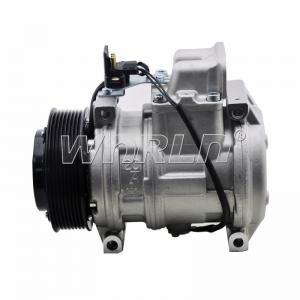
Add to Cart
DCP17006 0002300311 AC Compressor 10PA20C Auto 12V For Benz C/E/S W140/C140 WXMB010
Everything including humans requires regular maintenance after a stipulated span of time. Then why leave the car AC? The air conditioning unit is one of the best features and one of the topmost priority of what you may look while buying a new car. After a few months or maybe a year, you may have felt that the car AC is not as effective as it used to be. You may even have experienced slight suffocation when the car AC is running. This is when the time for getting your car AC serviced has arrived. But what happens if you keep running the AC even after these problems? This is what we’ll be dwelling on in this article. Let’s get started.
Parameter:
| Model Number | WXMB010 |
| Car Model | For Benz C/E/S W140/C140 |
| Compressor model | 10PA20C 8PK |
| Type | Air Conditioner Compressor |
| Year Model | 1991-1999 |
| OE No. | DCP17006/0002300311/1201300215/2300311/A0002300311/A0002345003 |
Product Picture


Car air conditioning compressor experiences damage, several diagnostic steps can be taken to identify the issue:
1. Visual Inspection: Start by visually inspecting the compressor for any obvious signs of damage such as leaks, cracks, or physical deformities. Pay close attention to the compressor pulley, clutch, and connections.
2. Listening for Unusual Noises: Run the engine and turn on the air conditioning system. Listen for any unusual noises such as grinding, rattling, or squealing coming from the compressor. These noises could indicate internal damage or mechanical issues.
3. Checking Compressor Operation: Monitor the operation of the compressor while the air conditioning system is running. If the compressor fails to engage when the AC is turned on, it could indicate a problem with the compressor clutch, electrical connections, or a lack of refrigerant.
4. Measuring Refrigerant Pressure: Use a manifold gauge set to measure the high and low side refrigerant pressures while the AC system is running. Abnormally high or low pressure readings could indicate compressor failure or other system issues.
5. Inspecting Refrigerant Lines: Inspect the refrigerant lines connected to the compressor for any signs of damage, leaks, or corrosion. A damaged line can lead to compressor failure due to inadequate refrigerant flow or contamination.
6. Testing Electrical Connections: Check the electrical connections leading to the compressor for any signs of damage, corrosion, or loose connections. Faulty electrical connections can prevent the compressor from operating properly.
7. Performing System Diagnostics: Use an automotive diagnostic tool to scan for any trouble codes related to the air conditioning system. Specific codes related to compressor failure or malfunction can provide valuable insight into the issue.
8. Consulting Service Manuals: Refer to the vehicle's service manual for specific diagnostic procedures and troubleshooting steps recommended by the manufacturer.
9. Seeking Professional Help: If the above steps do not identify the issue or if you're not comfortable performing diagnostics yourself, it's advisable to seek assistance from a qualified automotive technician or air conditioning specialist.
By following these diagnostic steps, you can effectively identify and troubleshoot issues with a damaged car air conditioning compressor.

